Art and education in the Hoyt’s newest exhibition, “Mystery & Benevolence: Masonic and Odd Fellows Art”, explores the art and accessories of two fraternal organizations steeped in symbols and coded systems, from special handles, gestures and passwords to ritualized performances that probably come from the Middle Ages.
Exhibition showcasing Masonic and Odd Fellows Art
Secret societies or societies with secrets ?
The exhibition starts on November 8th and runs until January 26th.
To the uninitiated, the intricately painted set pieces and ornate insignia are almost as mysterious as the practices themselves.
But according to the American Folk Art Museum, that mystery was intentional.
The objects on display from the Kendra and Allen Daniel Collection were designed to instil a sense of wonder while embodying a deep trust in community expressed through the bonds of ritual.
The over 80 carvings, textiles, sculptures, and ornaments in the main galleries feature themes of charity, fellowship, labor, passage, and wisdom, as well as brief histories of the influence of Freemasonry and Odd Fellows in America.
In fact, some of America’s Founding Fathers reached the higher levels of Freemasonry, including George Washington, Benjamin Franklin, and Paul Revere.
“There is often a lot of overlap in the symbols used by fraternities, particularly between Masons and Odd Fellows,” said Hoyt executive director Kimberly Koller-Jones, “but there are also differences in the way these are used Symbols manifest that are explored throughout the exhibition.”
Also read: Kimmel Cultural Campus Announces Return of Free Programming Showcasing the Talent and Creativity of Philly Artists
The emblems of the older Masonic order, first established in North America in 1730, are rational, orderly, and abstract.
The emblems of the Odd Fellows, founded in 1819, are somewhat more modern in comparison and more literal in expressing their ideals.
While Masons regarded charity as one of their “great principles” of brotherly love, relief and truth, the Odd Fellows were more explicit in instructing members in their charitable aims, with duties such as burying the dead, relieving those in need, educate visiting the sick and orphans.
Although both fraternities valued ideal behaviours, they have also drawn a lot of criticism due to their exclusivity since their inception.
The cryptic ciphers, rituals, and vows that still bind its members into a system of shared beliefs also shroud them in a secrecy that outsiders often find disconcerting.
Furthermore, the fraternities were developed by and for white men, according to the cultural norms of the time that excluded women and blacks.
The Odd Fellows were the first to form a sister organization in the Daughters of Rebekah in 1851. A black sailor, Peter Ogden, organized the Grand United Order of the Odd Fellows for blacks in America in 1843. Both are also represented in the exhibit.
Distrust almost destroyed these organizations in the 1830s. By the late 1860s, however, interest was sparked by men seeking the close camaraderie they experienced in the post-Civil War military. In fact, almost 200,000 men were initiated into the “golden age” of brotherhood, which lasted into the early 20th century.
Lawrence County was no exception. A supplementary exhibition in Hoyt’s Blair Sculpture Walkway, Fraternity of Brothers: Freemasonry in the Valley of New Castle, on loan from the Scottish Rite Cathedral, examines the regional history of Freemasonry which led to the building of the Scottish Rite Cathedral in 1924-25.
At the end of World War I, nearly 6,000 Freemasons met in the Temple Building in downtown New Castle.
The region’s economic growth encouraged members to consider building a much larger facility. The committee was chaired by the illustrious Brother John Scofield Wallace, the first Commander-in-Chief of the Valley of New Castle.
Several lots were purchased on Lincoln Avenue, then considered some of the finest real estate in the community, and Milwaukee firms RG Schmidt, architect, and SM Seisel, general contractor, were engaged.
The original construction photographs form the core of the Fraternity of Brothers exhibit, accompanied by an impressive collection of certificates, jewellery, furniture, regalia and other artifacts contributed by the senior members of New Castle and the surrounding lodges.
Notable items include an 1821 silk illustration of Masonic symbols, passed down through the generations of Mott Robertson’s family, and the trowel used by Samuel M. Goodyear, RW Grand Master of the Grand Lodge of Pennsylvania, to lay the foundation of the Scottish Rite Cathedral on June 10, 1925.
The opening ceremony drew thousands. It was the largest Masonic temple between New York and Chicago.
Other unexpected connections to the Hoyt have been revealed, such as Alex Crawford Hoyt’s own affiliation as Royal Arch Mason.
“It was rumored that the building, which would normally have faced downtown, was rotated so Crawford could see the front. Although we have since learned that this is not necessarily true, we can demonstrate that a number of Masonic symbols are incorporated into the design of the stained glass bookcase in his former living room.”
For the curious, a series of gallery talks, one-day workshops, tours of the cathedral (including a peek into the lodge rooms) and other activities provide ample opportunities to explore the exhibition’s content in different ways.
While most activities are free, registration is required at www.hoytartcenter.org/masons.
Both exhibits will remain on view at the Hoyt through January 26, 2023. Visiting hours are Tuesday, Wednesday and Thursday from 11 a.m. to 8 p.m. and Friday and Saturday from 11 a.m. to 4 p.m. Admission is free.
Mystery & Benevolence: Masonic and Odd Fellows Folk Art was organized by the American Folk Art Museum, New York from the Kendra and Allan Daniel Collection and is toured by International Arts & Artists, Washington, DC
website – http://hoytartcenter.org/masons/
Nov 8, 2022 – Jan 26, 2023
Photo credit: Artist unidentified, Independent Order of Odd Fellows Bow and Arrows Plaque for First Degree, 1860–1900, Paint and gold leaf on wood, with metal, Collection American Folk Art Museum, New York, Gift of Kendra and Allan Daniel, Photo by José Andrés Ramírez
Recent Articles: Masonic Art series
 Experience the power of Masonic art like never before with our handpicked selection of NFT collections now available on Opensea. Discover stunning works of art from talented artists across the world, all inspired by the ancient traditions and symbols of the Freemasonry. Don't miss out on the chance to own a piece of history - start exploring our Masonic art NFT projects today! |
 Digital Freemasonry NFT Marketplace Unlock the digital realm of Freemasonry with our exclusive NFT marketplace, designed for the modern-day Masonic community. Become one of 333 founders of Digital Freemasonry and gain access to a range of cutting-edge digital tools for the craft. Own a unique NFT as confirmation of your contribution to this ground-breaking initiative. Join us in shaping the future of Freemasonry - start exploring our NFT marketplace now! |
 Experience the legacy of Tubal Cain like never before with our unique collection of Masonic apron NFTs. Each of the 1,000 digital designs are one-of-a-kind and serve as a symbol of Masonic pride and tradition. And for those who prefer to have a physical item, these designs are also available as collectible aprons. Don't miss out on this rare opportunity to own a piece of Masonic history - start exploring our Tubal Cain Masonic apron NFTs now! |
 Discover the transcendent power of music through the eyes of John Philip Sousa. In a world where beauty intertwines with divine inspiration, music becomes a celestial language. Sousa's belief in melodies born from higher realms challenges us to seek the profound, divine connection in our creative expressions. Let music elevate your soul. |
 In a world brimming with wonder, pain, and confusion, the concept of love transcends all boundaries. In this thought-provoking poem, the poet dives into the depths of existence, questioning the nature of love, its transformative power, and the eternal quest to understand its true essence. Prepare to explore the enigma of love, as this poem delves into its many dimensions. |
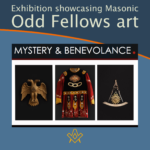 Exhibition showcasing Masonic, Odd Fellows art Art and education in the Hoyt’s newest exhibition, "Mystery & Benevolence: Masonic and Odd Fellows Art", explores the art and accessories of two fraternal organizations steeped in symbols and coded systems, from special handles, gestures and passwords to ritualized performances that probably come from the Middle Ages. |
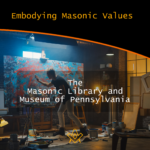 Since 2018, The Masonic Library and Museum of Pennsylvania’s “Embodying Masonic Values” open art competition has provided an opportunity for participants to explore Masonic values through art. Cash prizes are awarded to winners in five categories: Oil, Three-dimensional, Drawing and Print-making, Water-Based Medium and Digital Imagery. Most artwork is also available for sale. |
 Freemasonry in Popular Culture P4 - TV Part 4 of our series on Freemasonry in Popular Culture takes a look at some of the TV series that feature Freemasonry. With much intrigue into the supposed machinations of the Freemasons within business, politics and the police force, TV was a ripe medium for ridicule and sensationalist anti-Masonic propaganda. |
 Freemasonry in Popular Culture P3 - Comic Books and Graphic Novels Part 3 of our series on Freemasonry in Popular Culture takes a look at some of the comic books and graphic novels that feature Freemasonry. |
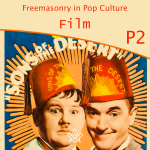 Freemasonry in Popular Culture P2 - Film Following on from Part 1 of Freemasonry in Pop Culture we take a look at Masonic depictions in film. |
 Freemasonry-membership is a mysterious NFT project that would be built across the Metaverse. Taking the idea from virtual lodges, the project is a huge mystery in terms of assets and value for the user. |
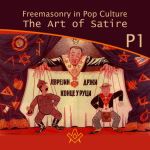 Freemasonry in Popular Culture P1 - The Art of Satire Freemasonry has been the subject of satire and lampooning since its inception in the 1700s courtesy |
 First Three Degrees of Freemasonry by Grant Wood For many of us, the name of the artist Grant Wood doesn’t ring any bells. But on a recent visit to the Grand Lodge of Iowa Masonic Library and Museums, I discovered a hidden gem – Grant Wood's vision of 'The First Three Degrees of Freemasonry'. |
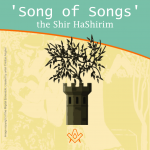 'Song of Songs' - the Shir HaShirim Freemason, composer and artistic director Laurențiu Ganea announces the premiere of his long-awaited composition of the 'Song of Songs' - the Shir HaShirim (also known as the 'Song of Solomon'). |
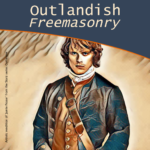 Martin Bogardus explores the Masonic characters and symbolism within the hugely successful 'Outlander' books and TV series. |
 The Masonic Art of Ari Roussimoff The Art, Masonic Aprons, and Magic of Ari Roussimoff - interviewed by Elena Llamas |
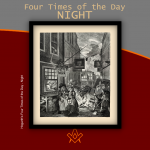 Hogarth's mockery of Freemasonry. A humorous depictions of life in the streets of London, the vagaries of fashion, and the interactions between the rich and poor. |
 This entertaining and infectious poem was written by an Ayeshire poet |
masonic knowledge
to be a better citizen of the world
share the square with two brothers

click image to open email app on mobile device







